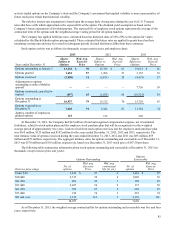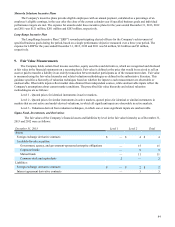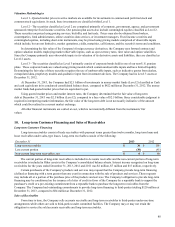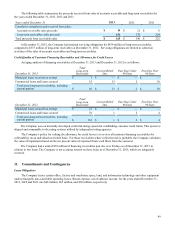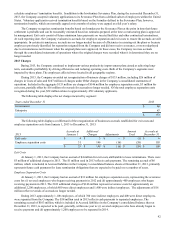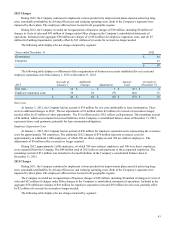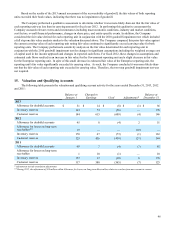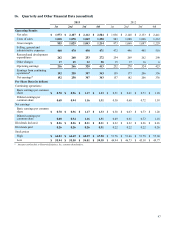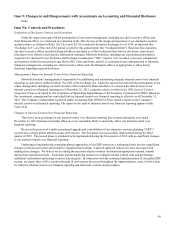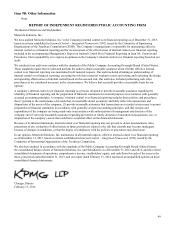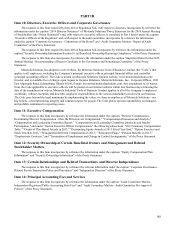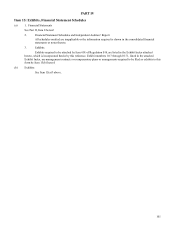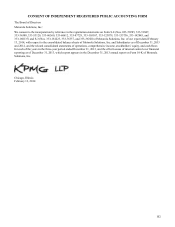Motorola 2013 Annual Report Download - page 94
Download and view the complete annual report
Please find page 94 of the 2013 Motorola annual report below. You can navigate through the pages in the report by either clicking on the pages listed below, or by using the keyword search tool below to find specific information within the annual report.
92
calculate employees’ termination benefits. In addition to the Involuntary Severance Plan, during the year ended December 31,
2013, the Company accepted voluntary applications to its Severance Plan from a defined subset of employees within the United
States. Voluntary applicants received termination benefits based on the formulas defined in the Severance Plan; however,
termination benefits, which are normally capped at six months of salary, were capped at a full year’s salary.
The Company recognizes termination benefits based on formulas per the Severance Plan at the point in time that future
settlement is probable and can be reasonably estimated based on estimates prepared at the time a restructuring plan is approved
by management. Exit costs consist of future minimum lease payments on vacated facilities and other contractual terminations.
At each reporting date, the Company evaluates its accruals for employee separation and exit costs to ensure the accruals are still
appropriate. In certain circumstances, accruals are no longer needed because of efficiencies in carrying out the plans or because
employees previously identified for separation resigned from the Company and did not receive severance, or were redeployed
due to circumstances not foreseen when the original plans were approved. In these cases, the Company reverses accruals
through the consolidated statements of operations where the original charges were recorded when it is determined they are no
longer needed.
2013 Charges
During 2013, the Company continued to implement various productivity improvement plans aimed at achieving long-
term, sustainable profitability by driving efficiencies and reducing operating costs. Both of the Company’s segments were
impacted by these plans. The employees affected were located in all geographic regions.
During 2013, the Company recorded net reorganization of business charges of $133 million, including $26 million of
charges in Costs of sales and $107 million of charges under Other charges in the Company’s consolidated statements of
operations. Included in the aggregate $133 million are charges of $146 million for employee separation costs, $3 million for
exit costs, partially offset by $16 million of reversals for accruals no longer needed. Of the total employee separation costs
recognized during the year, $52 million relates to approximately 450 voluntary applicants.
The following table displays the net charges incurred by segment:
Years ended December 31 2013
Government $ 86
Enterprise 47
$ 133
The following table displays a rollforward of the reorganization of businesses accruals established for exit costs and
employee separation costs from January 1, 2013 to December 31, 2013:
2013 Accruals at
January 1 Additional
Charges Adjustments Amount
Used Accruals at
December 31
Exit costs $ 4 $ 3 $ — $ (1) $ 6
Employee separation costs 31 146 (16)(58) 103
$ 35 $ 149 $ (16) $ (59) $ 109
Exit Costs
At January 1, 2013, the Company had an accrual of $4 million for exit costs attributable to lease terminations. There were
$3 million of additional charges in 2013. The $1 million used in 2013 reflects cash payments. The remaining accrual of $6
million, which is included in Accrued liabilities in the Company’s consolidated balance sheets at December 31, 2013, primarily
represents future cash payments for lease termination obligations that are expected to be paid over a number of years.
Employee Separation Costs
At January 1, 2013, the Company had an accrual of $31 million for employee separation costs, representing the severance
costs for: (i) severed employees who began receiving payments in 2012 and (ii) approximately 400 employees who began
receiving payments in 2013. The 2013 additional charges of $146 million represent severance costs for approximately an
additional 2,200 employees, of which 800 were direct employees and 1,400 were indirect employees. The adjustments of $16
million reflect reversals of accruals no longer needed.
During 2013, approximately 1,100 employees, of which 700 were indirect employees and 400 were direct employees,
were separated from the Company. The $58 million used in 2013 reflects cash payments to separated employees. The
remaining accrual of $103 million, which is included in Accrued liabilities in the Company’s consolidated balance sheet at
December 31, 2013, is expected to be paid, generally, within one year to: (i) severed employees who have already begun to
receive payments and (ii) approximately 1,200 employees to be separated in 2014.


